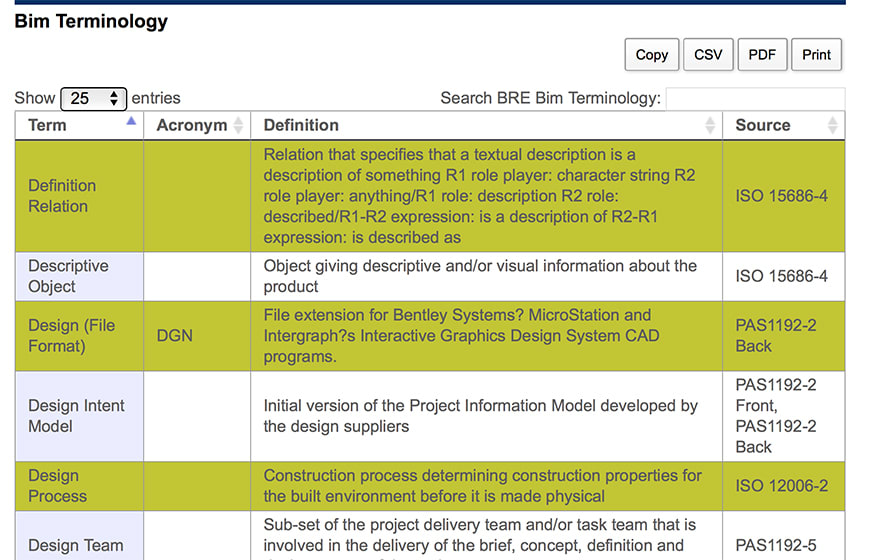BRE has created a BIM terminology tool that provides a term’s acronym, definition and source. Dan Rossiter, BIM consulting/training manager at BRE, talks us through the tool.
What exactly is the BIM terminology tool?
In its current form BRE’s BIM terminology tool is an online dynamic reference tool that filters through a schedule of BIM terminologies collected from a number of sources including British and international standards to provide a term’s acronym, definition and source.
Now that the tool works on our website, we are working to develop a mobile app to allow portable and offline viewing.
How does the tool differ from other list of key terms that are available?
Hopefully it shouldn’t. Our tool is a collection of published terms out of standards such as the BS 1192 series, BS 8541 series, and other relevant standards such as BS 7000-4, so our terms are all referenced from key documents.
Other lists, such as Bond Bryan’s BIM Dictionary, are based upon the same terminology for a number of items.
What was the motivation behind creating the BIM terminology tool?
It is somewhat ironic that a BIM methodology proposes a single source of the truth while many BIM standards and documents have differing terminology definitions. The motivation was therefore twofold:
First, it was identified that a number of standards did not use consistent definitions both in the UK and internationally. Often a definition in one document would not match another (or even within the same document!). As such, we compiled a matrix of all the terminology, highlighted where conflicts occurred and, together with Professor Mervyn Richards, selected the most appropriate definition where conflicts were identified.
Second, it was developed as an easy-to-use tool that would allow for quick searching of multiple terms from various standards in a single location. The original plan was to develop only the mobile app, but it became apparent that having this information on our portal would have value too.

The website provides a term’s acronym, definition and source.
Who is the tool aimed at?
Anyone who wants to check an acronym, term, or definition. The tool was not developed with a target audience in mind. It was developed to be a useful reference for anyone to navigate through the often difficult language used within BIM.
What do you hope the tool will achieve?
I don’t expect to the tool will achieve anything other than to be a useful bookmark to check term definitions. Our mission at BRE is to build a better world together, this tool is aligned to this mission by supporting others in the industry and aid a common understanding.
Do you think the number of terms related to BIM make the subject inaccessible?
I certainly think that the terminology causes issues. A key one is that BIM terminology results in a number of shibboleths: terms like “BIM Model”, “Data Drop” and others carry connotations of inferior knowledge which does little to encourage others to learn and adopt. BIM language is something I am keen to challenge, such as my article on BIM that only used the top 1,000 most common words in the English Language. Certainly BIM can be discussed in plain language.
What else is the BRE doing to help demystify BIM?
On our portal where the terminology tool can be found we also have links to the current core BIM standards, as well as a number of other useful standards such as BS 7000-4, BS 8541 object standards, as well as the CIC documentation and the CPIx template documents.
Our BIM education courses are also a key part of our role in demystifying the industry. Written in collaboration with Avanti, we have a BIM Level 2 fundamentals course aligned to the BIM Task Group’s Learning Outcome Framework aimed at supporting the industry. The course has been incredibly popular with more than 1,000 attendees to date.

A number of standards did not use consistent definitions. Often a definition in one document would not match another. As such, we compiled a matrix of all the terminology, highlighted where conflicts occurred and selected the most appropriate definition where conflicts were identified.– Dan Rossiter, BRE
Comments
Comments are closed.
















I was expecting a mention of the largest BIM Dictionary available (http://BIMdictionary.com) which also covers UK terminology. I wonder why both the author and the editor have failed to include even a reference? I know this is not an academic article where referencing international, larger and preceding efforts is mandatory, but it – if the declared mission is “supporting others in the industry and aid a common understanding”, then I’m right to feel a bit disappointed.
The idea of a tool is good but it doesn’t seem to have many acronym’s? While one the the most confusing things about learning BIM is the vast number of acronym’s the novice must become familiar with.
Hi Raymond, all of the acronyms identified within the standards have been included.
Of the 368 entries there are 58 acronyms, if you use the search tool underneath the second column you can search exclusively by acronym.
For me the use of acronyms in BIM is its biggest downfall. Why does it need its own language? Lets tell it like it is?